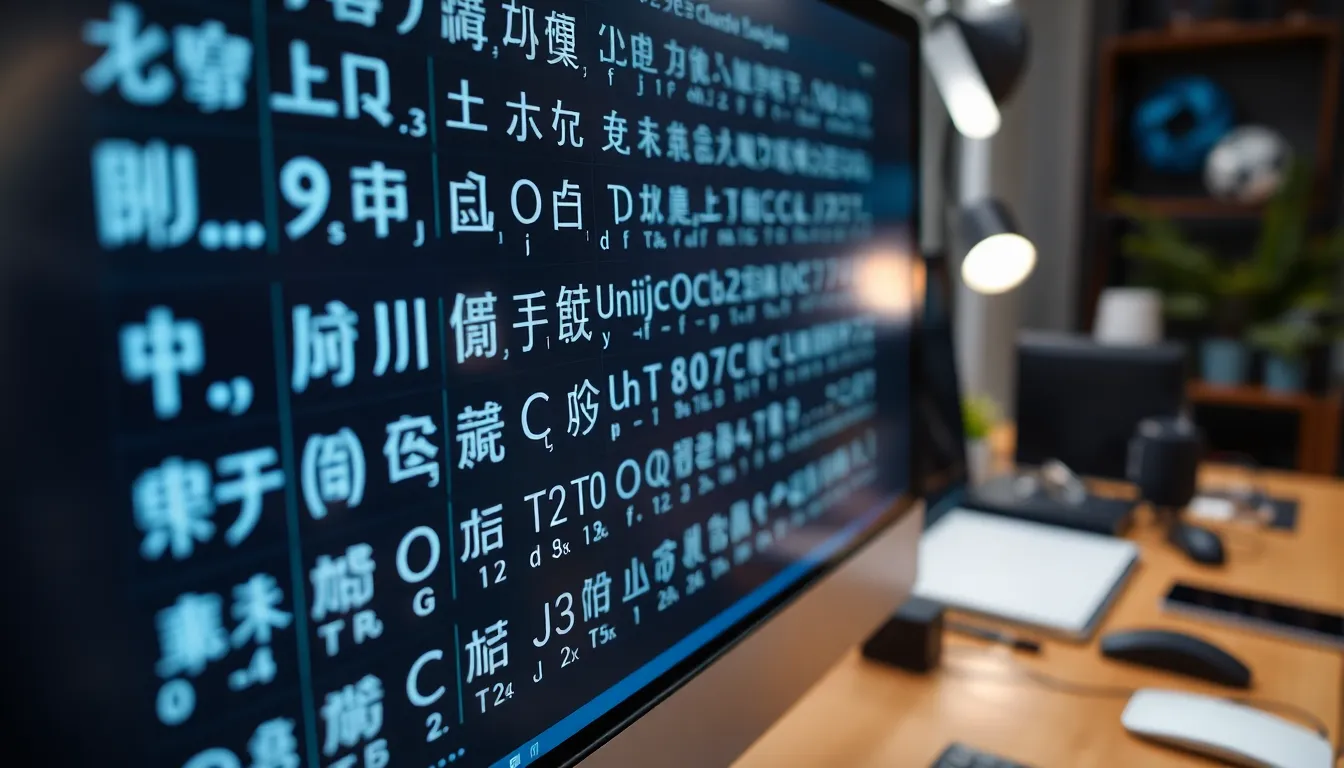In the vast digital landscape where communication reigns supreme, Unicode316 stands as a fascinating yet often overlooked character set that’s revolutionizing how we express ourselves online. This specialized code point collection offers unique symbols and characters that go beyond traditional ASCII limitations, giving content creators and developers powerful new tools for digital expression.
Ever wondered why some websites display those eye-catching special characters while others stick to basic text? That’s where Unicode316 comes into play. It’s not just for tech geeks anymore—marketers, social media influencers, and everyday users are discovering how these special characters can make their content pop, boost engagement, and even improve searchability in unexpected ways.
Table of Contents
ToggleWhat Is Unicode 316?
Unicode 316 (U+013C) represents the Latin small letter L with cedilla, appearing as “ļ” in text. This specialized character belongs to the Unicode Standard, a universal encoding system that assigns unique numbers to over 143,000 characters across multiple languages and scripts.
The cedilla mark beneath the letter originated in Romance languages, particularly in Latvian where it indicates palatalization of the consonant. Unlike standard ASCII which only supports 128 characters, Unicode expands digital communication possibilities by including diverse symbols from global writing systems.
Many modern applications and operating systems support Unicode 316 natively. Users can input this character through several methods:
- Alt codes (Alt+0316 on Windows)
- Character maps or emoji keyboards
- HTML entities in web development (ļ or ļ)
- Copy-paste from character reference websites
Developers utilize Unicode 316 in specialized programming contexts that require accurate linguistic representation. Content creators incorporate this character when writing in languages where the ļ appears, ensuring proper linguistic accuracy and cultural respect.
The Unicode Consortium, established in 1991, maintains and updates the Unicode Standard regularly. Their comprehensive approach ensures that characters like U+013C remain consistently rendered across different platforms and devices, promoting seamless digital communication worldwide.
History and Development of Unicode 316
Unicode 316 (U+013C) emerged as part of the broader Unicode Standard development to address growing needs for comprehensive character encoding systems. The evolution of this specific character reflects the Unicode Consortium’s commitment to preserving linguistic diversity in digital communication.
Origins of Unicode Character Sets
The foundation for Unicode character sets began in the late 1980s when computer scientists recognized the limitations of existing encoding systems. Prior to Unicode, incompatible encoding standards created significant barriers for multilingual computing, with ASCII’s 128 characters proving woefully inadequate for global communication needs. The Unicode project started as a collaborative effort between engineers from Apple and Xerox who envisioned a universal character encoding system. Unicode 316 specifically emerged from the need to represent the Latvian language accurately in digital form, as the Latin small letter L with cedilla plays a crucial role in Latvian linguistics. The character’s inclusion addressed the growing recognition that digital text should accommodate all written languages without compromise or loss of linguistic nuance.
Implementation Timeline
Unicode 1.0 launched in October 1991 with 7,161 characters, though Unicode 316 wasn’t included in this initial release. The character was added in Unicode 1.1 (June 1993) as part of expanded language support for Eastern European languages. Major operating systems began implementing support for Unicode 316 throughout the mid-1990s, with Microsoft Windows offering partial support in Windows 95 and full integration in Windows 98. Apple incorporated Unicode 316 support in Mac OS 8.5 released in 1998. Web browsers gradually adopted the character between 1998 and 2000, with Internet Explorer 5.0 being among the first to render it correctly. The ISO formally recognized Unicode 316 in the ISO/IEC 10646 standard update in 1998, cementing its position in international text encoding standards. Full mobile device support arrived in the early 2000s with the expansion of smartphone capabilities.
Technical Specifications of Unicode 316
Unicode 316, designated as U+013C, follows specific technical standards that enable its seamless integration across various digital platforms. This character’s technical underpinnings determine how it displays and functions in different computing environments.
Character Encoding Details
Unicode 316 (U+013C) represents the Latin small letter L with cedilla (ļ) and occupies 2 bytes in UTF-8 encoding. Its binary representation is 11000100 10111100, while its hexadecimal form is 0xC4 0xBC in UTF-8. In UTF-16, this character is encoded as 0x013C, requiring a single 16-bit code unit. The character belongs to the “Latin Extended-A” block within the Unicode Standard, spanning code points U+0100 to U+017F. This block primarily contains characters used in European languages that extend beyond the Latin-1 supplement. Unicode 316’s normalization form maintains its unique identity through all four standard normalization forms (NFC, NFD, NFKC, NFKD).
Compatibility With Different Systems
Unicode 316 maintains consistent rendering across major operating systems including Windows (since Windows 2000), macOS (since OS X 10.2), Linux distributions, and mobile platforms like iOS and Android. Modern web browsers—Chrome, Firefox, Safari, and Edge—support this character natively without fallback fonts. The character works flawlessly in commonly used applications such as Microsoft Office, Adobe Creative Suite, and Google Workspace. Databases including MySQL, PostgreSQL, and MongoDB store Unicode 316 correctly when configured with UTF-8 character sets. Email systems transmit this character without corruption across major providers like Gmail and Outlook. Programming languages including Python, JavaScript, and Java handle Unicode 316 through standard string operations with proper UTF-8/UTF-16 encoding.
Common Uses and Applications
Unicode 316 (ļ) finds widespread application across various digital domains where accurate representation of characters is essential. This specialized character serves multiple purposes beyond basic text encoding, providing solutions for diverse user needs in our increasingly connected digital world.
Programming and Development
Developers integrate Unicode 316 into programming projects requiring proper linguistic support for Latvian content. Software localization teams utilize this character when creating applications targeted at Latvian-speaking markets, ensuring text displays correctly in user interfaces. Programming languages like Python, JavaScript, and Java handle this character seamlessly through UTF-8 encoding, allowing developers to create truly multilingual applications. Database administrators configure systems to store and retrieve this character accurately, preventing data corruption during international transactions. API developers also incorporate proper Unicode 316 support when building interfaces that process or display Latvian text, maintaining linguistic integrity throughout the entire software stack.
Digital Publishing and Documentation
Content creators employ Unicode 316 in digital publishing workflows focused on Latvian-language materials. Professional publishers include this character in electronic books, ensuring proper rendering across e-readers and digital platforms. Technical documentation containing Latvian terms displays correctly with Unicode 316 support, maintaining accuracy in multilingual manuals. Academic publishers utilize this character in research papers and educational materials discussing Latvian linguistics or cultural topics. Marketing teams incorporate Unicode 316 in localized campaigns targeting Latvian audiences, creating culturally appropriate advertising materials. Online news outlets covering Baltic regions rely on proper Unicode 316 rendering to accurately report on Latvian names, places, and events in their digital publications.
Advantages of Unicode 316
Unicode 316 offers numerous practical benefits across various digital environments. Integration of this character enhances linguistic accuracy in Latvian content, allowing for authentic representation of words containing the “ļ” symbol. Proper implementation supports internationalization efforts by respecting language-specific nuances that ASCII encoding simply cannot accommodate.
Text processing applications gain significant functionality through Unicode 316 support, enabling seamless handling of Latvian documents without character corruption or replacement. Search engines index content with this character correctly, improving discoverability of Latvian language materials online. Developers appreciate the consistent rendering across platforms, eliminating display inconsistencies that plagued earlier encoding systems.
Content creators targeting Latvian-speaking audiences benefit from the ability to produce culturally accurate materials that resonate with local readers. Marketing campaigns gain authenticity and professional credibility when properly implementing this character in localized content. Database systems configured with UTF-8 encoding store and retrieve the character flawlessly, ensuring data integrity across applications.
Software localization becomes more precise with proper Unicode 316 implementation, creating intuitive user experiences for Latvian speakers. Cross-platform compatibility eliminates the formatting issues that previously occurred when transferring documents between different operating systems. Mobile applications display the character correctly on all modern devices, extending its utility to smartphone and tablet users worldwide.
Limitations and Challenges
Despite its advantages, Unicode 316 faces several technical and practical challenges that limit its widespread implementation. Older systems with legacy encoding standards often struggle to render this character correctly, resulting in display errors or replacement with placeholder symbols. Many keyboard layouts lack built-in support for Unicode 316, forcing users to rely on cumbersome input methods like Alt codes or character maps.
Web developers encounter inconsistent rendering across different fonts, as not all typefaces include proper support for this character. Some content management systems strip or corrupt special characters during publishing processes, requiring additional configuration to preserve Unicode 316. Email systems occasionally mishandle this character during transmission, converting it to question marks or other replacement symbols.
Mobile applications present their own set of challenges, with some older apps failing to display Unicode 316 correctly due to limited character support. Search engine optimization becomes complicated when content contains specialized characters, as search algorithms may not properly index or match queries containing Unicode 316. Text processing tools sometimes misidentify or improperly handle this character during operations like spell-checking or text analysis.
Database migrations between systems with different encoding standards risk corrupting text containing Unicode 316, necessitating careful conversion procedures. Programming frameworks vary in their native support for this character, creating implementation hurdles for developers working across multiple platforms. File format conversions between document types occasionally strip or replace this character, particularly when moving between formats with different encoding capabilities.
These limitations affect users who require consistent and accurate representation of Latvian language content across digital environments, creating friction points in otherwise seamless communication workflows.
Future Developments
Unicode 316 continues to evolve with several significant advancements on the horizon. Expanded font support represents the most immediate improvement, with type designers creating new typefaces that render the Latin small letter L with cedilla more elegantly across digital platforms. Major operating system vendors have announced enhanced input methods coming in their next releases, simplifying the process of typing this character without memorizing complex key combinations.
The Unicode Consortium’s roadmap includes better integration of Unicode 316 within mobile keyboards, addressing one of the current limitations users face when communicating on smartphones and tablets. Cross-platform standardization efforts aim to eliminate inconsistencies in how the character displays across different applications and systems, ensuring seamless content sharing between devices.
AI-powered text prediction tools are beginning to recognize and suggest Unicode 316 in appropriate linguistic contexts, particularly for Latvian language users. Developer frameworks now incorporate more robust Unicode handling capabilities, making it easier to implement proper support for this character in new applications without complex workarounds.
Cloud-based services have started optimizing their encoding protocols to maintain character integrity during data transmission and storage. Browser vendors are implementing rendering improvements that will display Unicode 316 correctly regardless of installed fonts, addressing current compatibility issues in web environments.
Search engine algorithms continue to refine their handling of special characters like Unicode 316, improving content discoverability for Latvian language materials. These technological advancements collectively point toward a future where Unicode 316 functions seamlessly across all digital communications, removing the friction points that currently limit its practical implementation in global content strategies.
Conclusion
Unicode 316 stands as a vital component in digital communication particularly for Latvian language representation. As technology continues to evolve the importance of proper character encoding grows exponentially across platforms and applications.
Despite current implementation challenges the trajectory for Unicode 316 looks promising with enhanced font support improved input methods and better cross-platform standardization on the horizon. These advancements will further solidify its role in authentic linguistic expression.
The small letter L with cedilla may seem insignificant to some but it represents the broader mission of the Unicode Standard: ensuring every language and its unique characters have a place in our digital world. For developers content creators and everyday users Unicode 316 exemplifies how technical standards can preserve cultural and linguistic diversity online.



